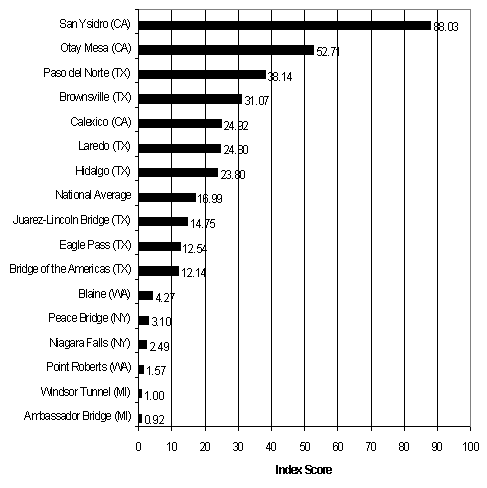
Inspection of the Secure Electronic Network
for Travelers' Rapid Inspection
Report Number I-2000-019
June 2000
Assessing Risk Levels at Existing and Proposed SENTRI Pilot Sites:
One Option for INS to Consider
Assessing risk is not only important for determining what security features and other safeguards are required for proposed SENTRI pilot sites, but also for determining whether current features and safeguards are adequate for SENTRI's existing pilot sites. Analyzing border violation rates and commuter traffic volume data from FY 1996 through FY 1998, we developed an index that measures risk in relation to commuter traffic volume. This index not only allows for useful comparisons to be made between risk levels at different ports-of-entry, but could also be used to determine what security features and safeguards may be needed at each of SENTRI's pilot sites.
In assessing risk, we included the three most serious categories of border violations: the number of fraudulent documents intercepted, the number of individuals involved in smuggling narcotics, and the number of individuals intercepted in the course of being illegally smuggled into the United States. INS officials told us they consider these three categories to be the best indicators of risk.
Our analysis included both existing and proposed SENTRI pilot sites. For comparative purposes, our analysis also included the two existing PACE sites at Blaine and Point Roberts, Washington. Finally, because SENTRI is primarily intended for higher-volume ports-of-entry, our analysis also included ports-of-entry where an average of 10 million primary inspections or more were conducted per year from FY 1996 through FY 1998.
A score ranging from 0 to 100 has been assigned to each of the ports-of-entry included in our analysis based on the total number of border violations we considered divided by the total number of primary inspections conducted. A score has also been assigned to the national average as a means for drawing relative comparisons across all land ports-of-entry. A score of 0 means there were no border violations reported during any given year from FY 1996 through FY 1998; a score of 100 means 1,000 border violations occurred for every 1 million primary inspections conducted during any given year during this same period. The risk index score is adjusted for commuter traffic volume. Historically, fewer than 800 enforcement actions and border violations occur for every 1 million primary inspections conducted at any land port-of-entry during any given year.
Risk index scores are included on the following page:
Risk Index Scores for Selected Land Ports-of-Entry
(Adjusted for Commuter Traffic Volume)
